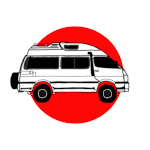Paysandú
Strangers in a Strange Town
We spend time in Paysandú with family. Located on the banks of the River Uruguay, it is Uruguay’s fourth largest city. It’s also a border city, with a bridge spanning the river to Argentina.
Paysandú is a very different place to Montevideo. It doesn’t feel like a city and it is a much more suburban place, more town than city. Gone are the high rises, replaced by mostly single storey housing in states for repair that range from immaculate to ramshackle and often next door to one another. What everybody has in common are bars on the windows and an outdoor grill. There is one tower in the city and it’s visible from miles around.
Everyone knows everyone else and as strangers in town we become a tourist attraction.
Who’s Going to Run Over Your Wild Horses?
I get my first taste of driving in South America. I upset a few motorcyclists and only get terrorised by a small handful of dogs. But I manage not to hit anything , eventually I get the hang of the cross roads and become quite expert at animal avoidance. The list of lucky animals is long and includes a herd of horses convinced of greener grass on a roundabout, cows, chickens and, of course, packs of dogs. Dogs are everywhere. Crime is a problem here and they’re mostly used as guard dogs, still pets, but they are primarily there for protection.
There’s enough to do in the vicinity to keep us busy and we also take longer trips out to various parks and thermal baths, which are a popular attraction.
In Salto we are also able to take a tour of the hydro electric plant that spans the river – a joint project between Uruguay and Argentina to generate power from the flowing water. It’s a fascinating piece of engineering and the tour is easy enough for me to follow.
Don’t Cry For Me
We take our first fleeting forays into Argentina. Quick runs to buy cheap fuel and goods.
Leaving Uruguay and entering Argentina is a quick operation. Once across the bridge we immediately dive into the petrol station, along with most everyone else.
Two things are happening here. Money is exchanged. This is not an official money exchange, this is the Blue Dollar, money changing hands on the black market and nearly twice the official rate. We let the locals handle the money exchange, we won’t get such a good rate as them. Fuel is bought and at today’s rate it works out at about half the price of filling in Uruguay.
Located next to the petrol station are the supermarkets. They only stock goods that are legal to take back into Uruguay and they are super cheap for Uruguayans. We’re not even into the border town of Colon yet, this is just a dusty, grubby, litter strewn wasteland of cut price shopping. I’m sure many people complete their purchases and head straight back across the bridge.
We complete our shopping spree and follow the road into the town of Colon. I’m not expecting too much, but I find it to be quite a lively place. Shops and restaurants are busy. We stop in one of the many cafes for merienda, an afternoon tea type affair and promptly eat too much cake.
I feel a little nervous about being in Argentina. The government seem to be pushing the Las Malvinas/Falkland Islands issue again. I’m told it’s because the government are in trouble but I only have to look back home to see how political agendas can stoke fear and hate. Not that I expect any government really cares about the islands, the inhabitants or even the penguins, but they do care about its natural resources. Anyhow, I don’t experience any issues and relax a little.
Returning to Uruguay is a slower process, and the traffic queue is long and slow moving. Luckily we have cut price snacks to keep us going.
